FORD KUGA 2010 1.G Owners Manual
Manufacturer: FORD, Model Year: 2010, Model line: KUGA, Model: FORD KUGA 2010 1.GPages: 226, PDF Size: 8.07 MB
Page 151 of 226
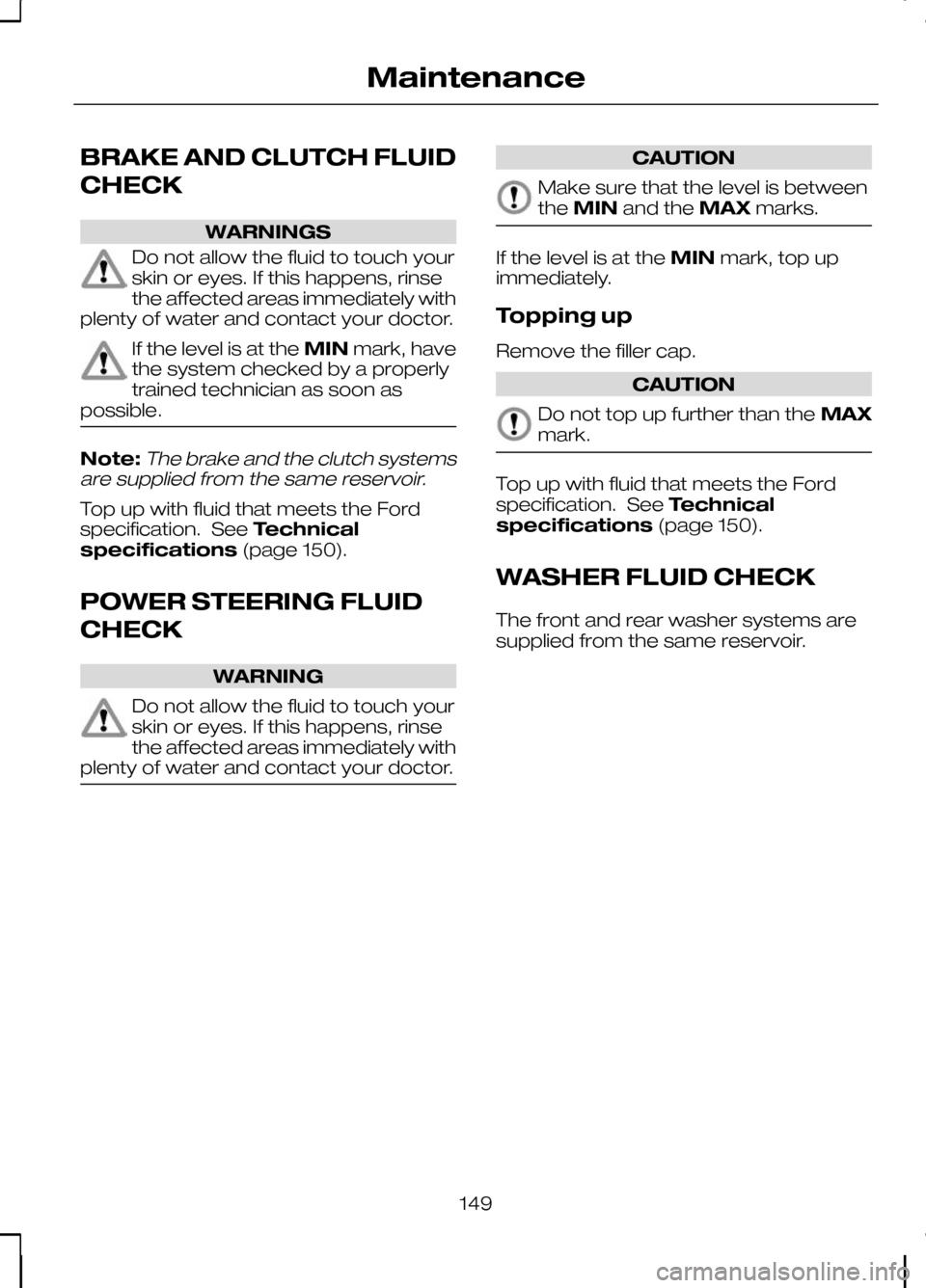
BRAKE AND CLUTCH FLUID
CHECK
WARNINGS
Do not allow the fluid to touch your
skin or eyes. If this happens, rinse
the affected areas immediately with
plenty of water and contact your doctor. If the level is at the
MINmark, have
the system checked by a properly
trained technician as soon as
possible. Note:The brake and the clutch systems
are supplied from the same reservoir.
Top up with fluid that meets the Ford
specification. See Technical
specifications (page 150).
POWER STEERING FLUID
CHECK WARNING
Do not allow the fluid to touch your
skin or eyes. If this happens, rinse
the affected areas immediately with
plenty of water and contact your doctor. CAUTION
Make sure that the level is between
the
MIN and the MAXmarks. If the level is at the
MINmark, top up
immediately.
Topping up
Remove the filler cap. CAUTION
Do not top up further than the
MAX
mark. Top up with fluid that meets the Ford
specification. See
Technical
specifications (page 150).
WASHER FLUID CHECK
The front and rear washer systems are
supplied from the same reservoir.
149
Maintenance
Page 152 of 226
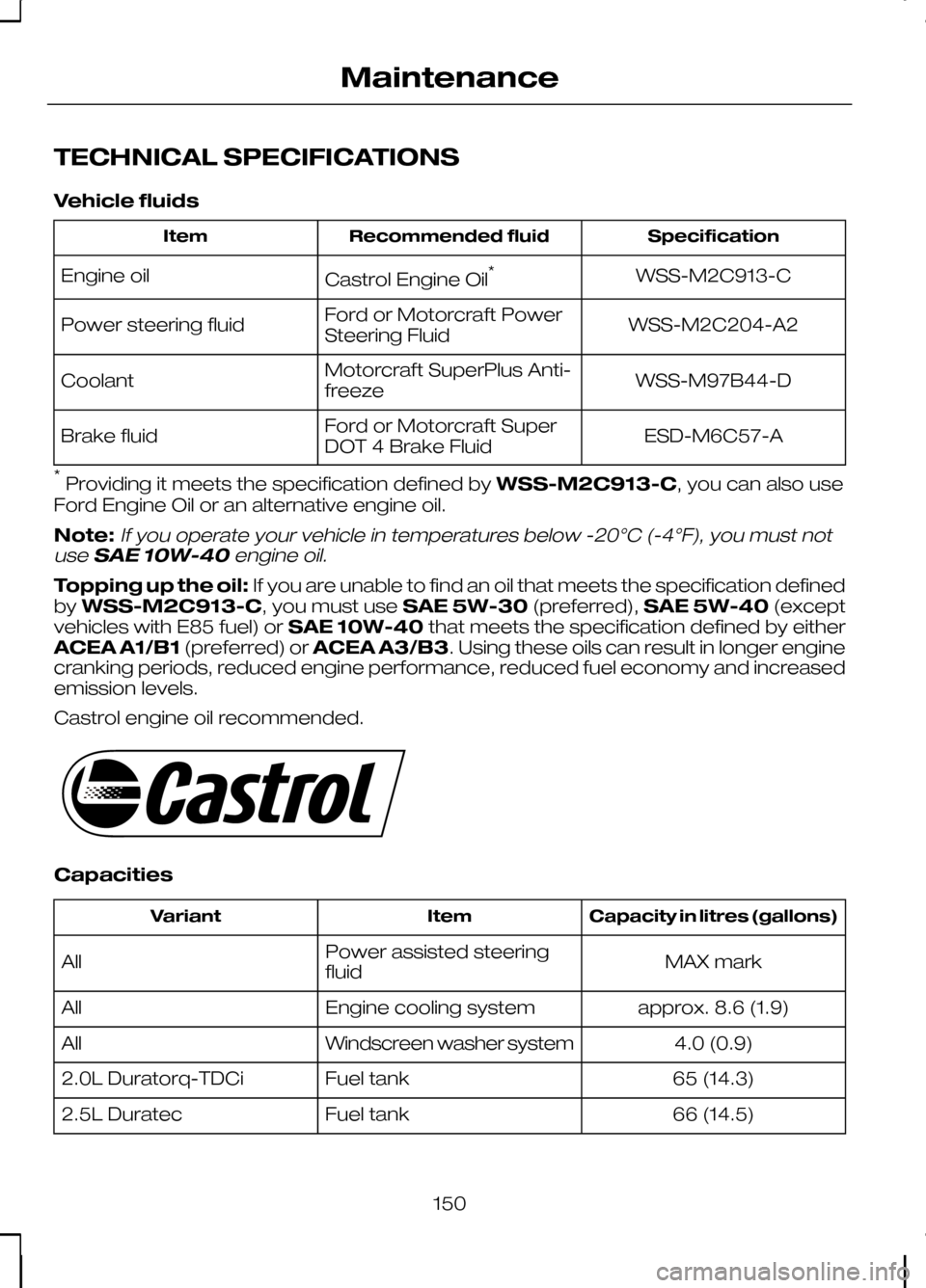
TECHNICAL SPECIFICATIONS
Vehicle fluids
Specification
Recommended fluid
Item
WSS-M2C913-C
Castrol Engine Oil *
Engine oil
WSS-M2C204-A2
Ford or Motorcraft Power
Steering Fluid
Power steering fluid
WSS-M97B44-D
Motorcraft SuperPlus Anti-
freeze
Coolant
ESD-M6C57-A
Ford or Motorcraft Super
DOT 4 Brake Fluid
Brake fluid
* Providing it meets the specification defined by WSS-M2C913-C, you can also use
Ford Engine Oil or an alternative engine oil.
Note:If you operate your vehicle in temperatures below -20°C (-4°F), you must not
use SAE 10W-40 engine oil.
Topping up the oil: If you are unable to find an oil that meets the specification defined
by WSS-M2C913-C, you must use SAE 5W-30(preferred),SAE 5W-40 (except
vehicles with E85 fuel) or SAE 10W-40that meets the specification defined by either
ACEA A1/B1 (preferred) orACEA A3/B3. Using these oils can result in longer engine
cranking periods, reduced engine performance, reduced fuel economy and increased
emission levels.
Castrol engine oil recommended. Capacities
Capacity in litres (gallons)
Item
Variant
MAX mark
Power assisted steering
fluid
All
approx. 8.6 (1.9)
Engine cooling system
All
4.0 (0.9)
Windscreen washer system
All
65 (14.3)
Fuel tank
2.0L Duratorq-TDCi
66 (14.5)
Fuel tank
2.5L Duratec
150
MaintenanceE115472
Page 153 of 226
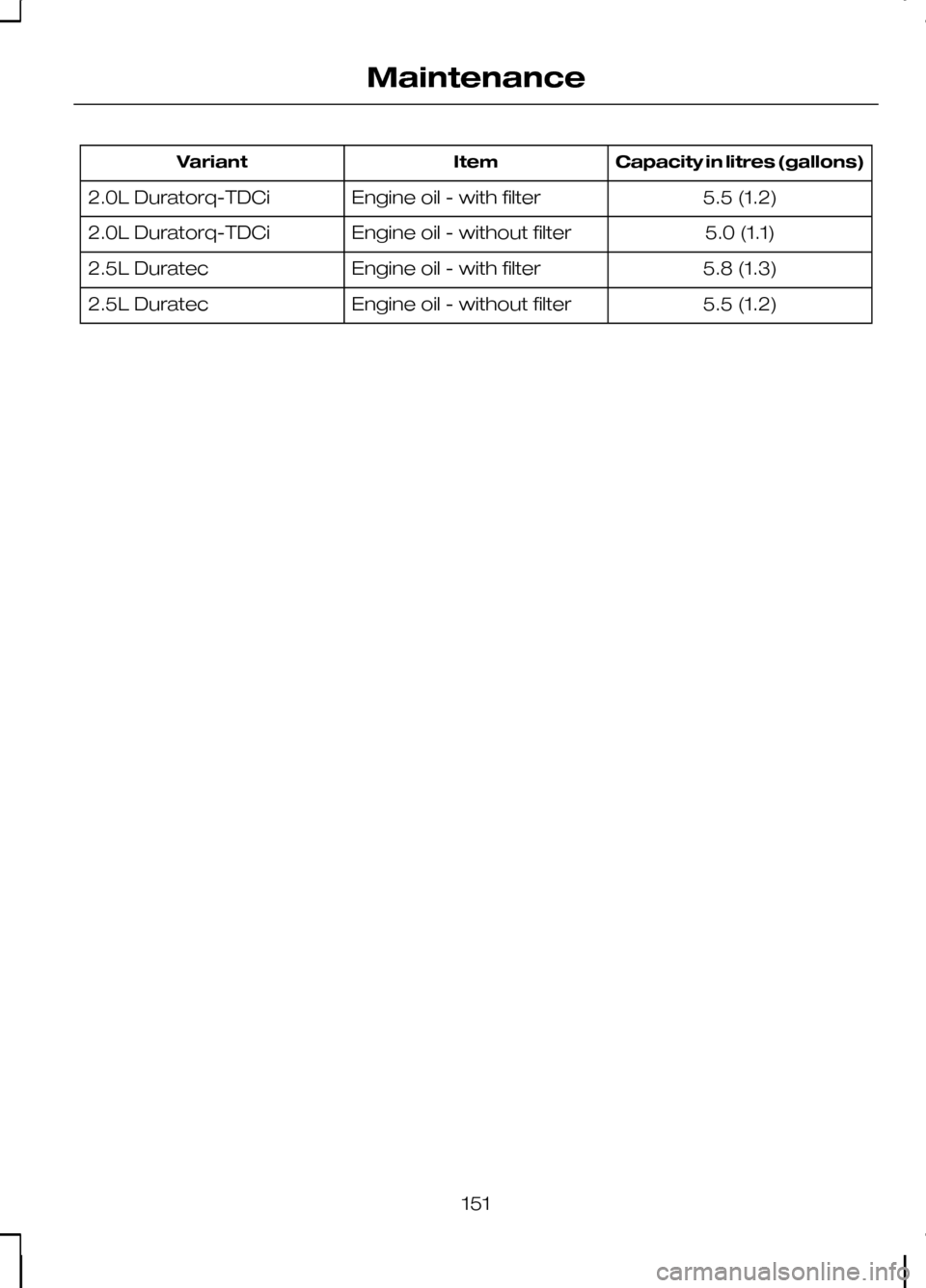
Capacity in litres (gallons)
Item
Variant
5.5 (1.2)
Engine oil - with filter
2.0L Duratorq-TDCi
5.0 (1.1)
Engine oil - without filter
2.0L Duratorq-TDCi
5.8 (1.3)
Engine oil - with filter
2.5L Duratec
5.5 (1.2)
Engine oil - without filter
2.5L Duratec
151
Maintenance
Page 154 of 226
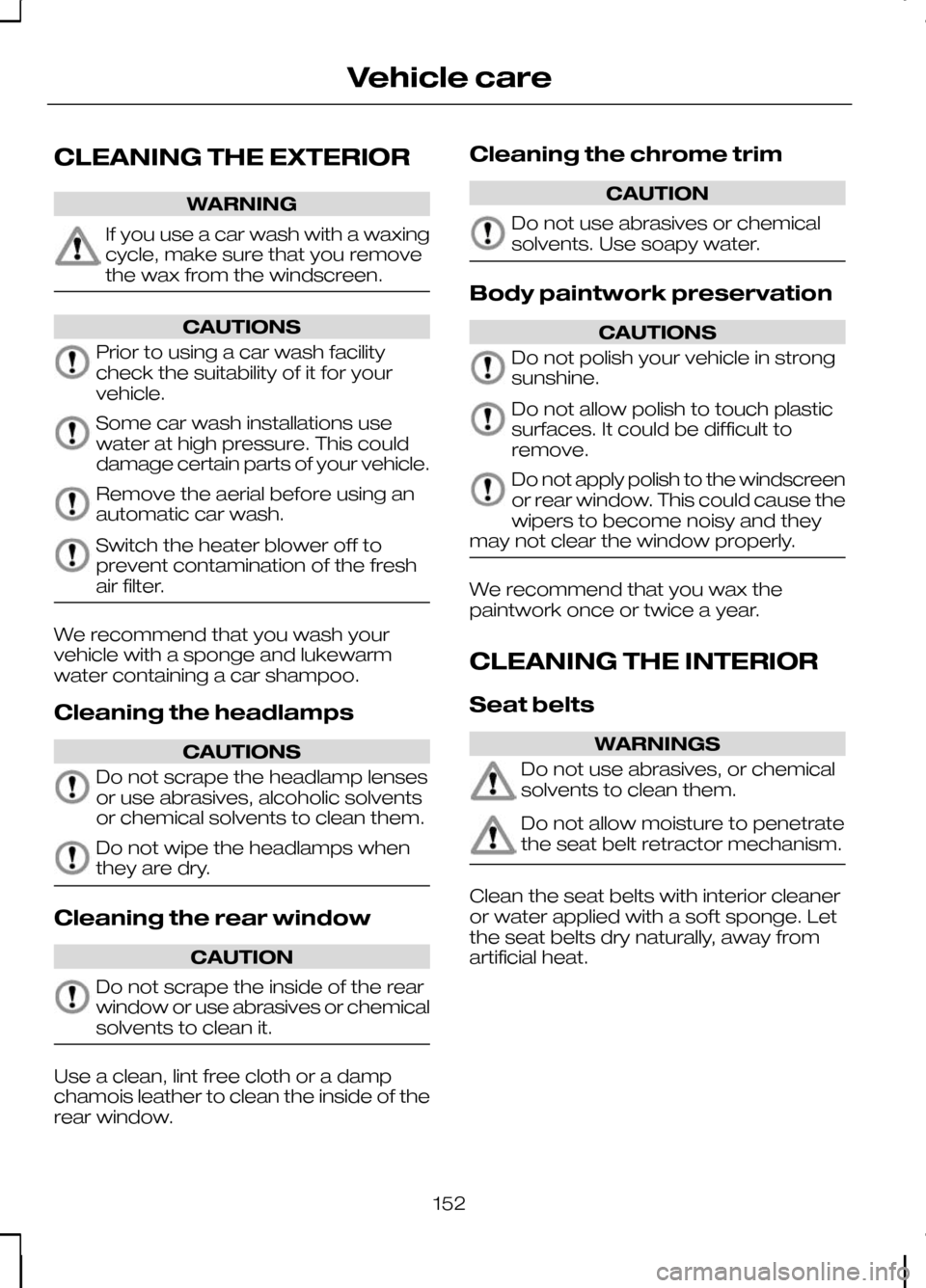
CLEANING THE EXTERIOR
WARNING
If you use a car wash with a waxing
cycle, make sure that you remove
the wax from the windscreen.
CAUTIONS
Prior to using a car wash facility
check the suitability of it for your
vehicle.
Some car wash installations use
water at high pressure. This could
damage certain parts of your vehicle.
Remove the aerial before using an
automatic car wash.
Switch the heater blower off to
prevent contamination of the fresh
air filter.
We recommend that you wash your
vehicle with a sponge and lukewarm
water containing a car shampoo.
Cleaning the headlamps
CAUTIONS
Do not scrape the headlamp lenses
or use abrasives, alcoholic solvents
or chemical solvents to clean them.
Do not wipe the headlamps when
they are dry.
Cleaning the rear window
CAUTION
Do not scrape the inside of the rear
window or use abrasives or chemical
solvents to clean it.
Use a clean, lint free cloth or a damp
chamois leather to clean the inside of the
rear window. Cleaning the chrome trim CAUTION
Do not use abrasives or chemical
solvents. Use soapy water.
Body paintwork preservation
CAUTIONS
Do not polish your vehicle in strong
sunshine.
Do not allow polish to touch plastic
surfaces. It could be difficult to
remove.
Do not apply polish to the windscreen
or rear window. This could cause the
wipers to become noisy and they
may not clear the window properly. We recommend that you wax the
paintwork once or twice a year.
CLEANING THE INTERIOR
Seat belts
WARNINGS
Do not use abrasives, or chemical
solvents to clean them.
Do not allow moisture to penetrate
the seat belt retractor mechanism.
Clean the seat belts with interior cleaner
or water applied with a soft sponge. Let
the seat belts dry naturally, away from
artificial heat.
152
Vehicle care
Page 155 of 226
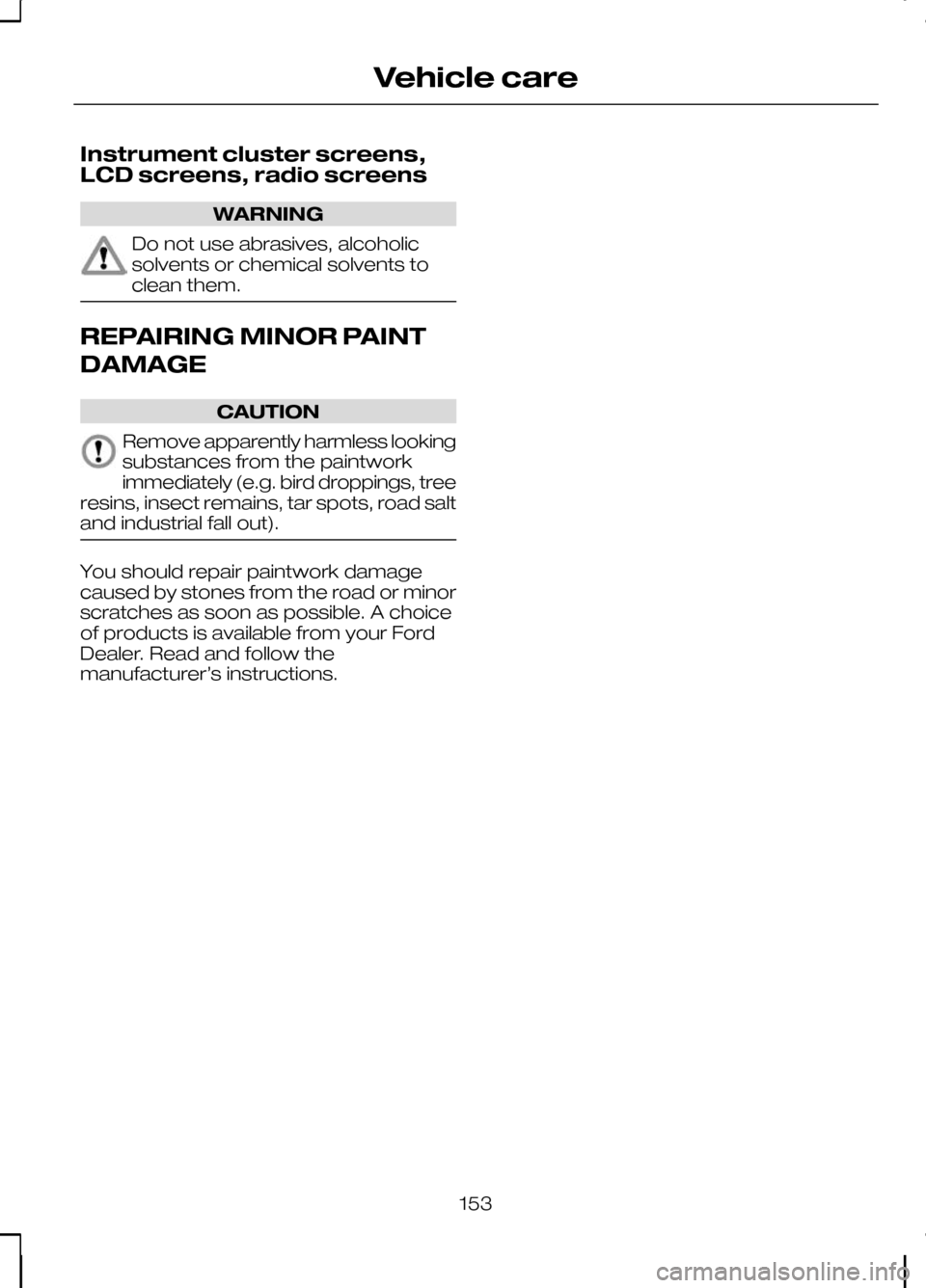
Instrument cluster screens,
LCD screens, radio screens
WARNING
Do not use abrasives, alcoholic
solvents or chemical solvents to
clean them.
REPAIRING MINOR PAINT
DAMAGE
CAUTION
Remove apparently harmless looking
substances from the paintwork
immediately (e.g. bird droppings, tree
resins, insect remains, tar spots, road salt
and industrial fall out). You should repair paintwork damage
caused by stones from the road or minor
scratches as soon as possible. A choice
of products is available from your Ford
Dealer. Read and follow the
manufacturer’s instructions.
153
Vehicle care
Page 156 of 226
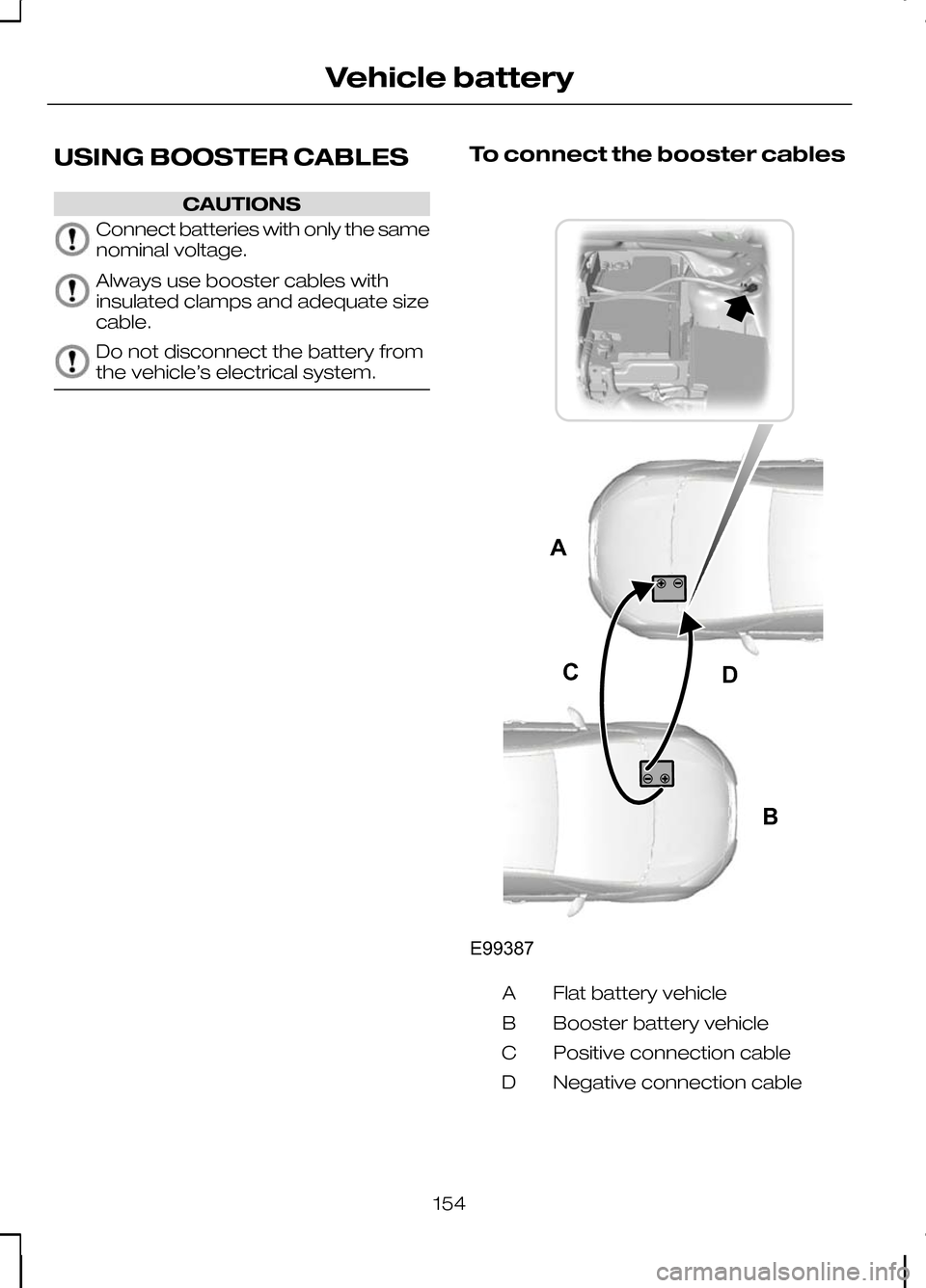
USING BOOSTER CABLES
CAUTIONS
Connect batteries with only the same
nominal voltage.
Always use booster cables with
insulated clamps and adequate size
cable.
Do not disconnect the battery from
the vehicle’s electrical system. To connect the booster cables
Flat battery vehicle
A
Booster battery vehicle
B
Positive connection cable
C
Negative connection cable
D
154
Vehicle batteryABCDE99387
Page 157 of 226
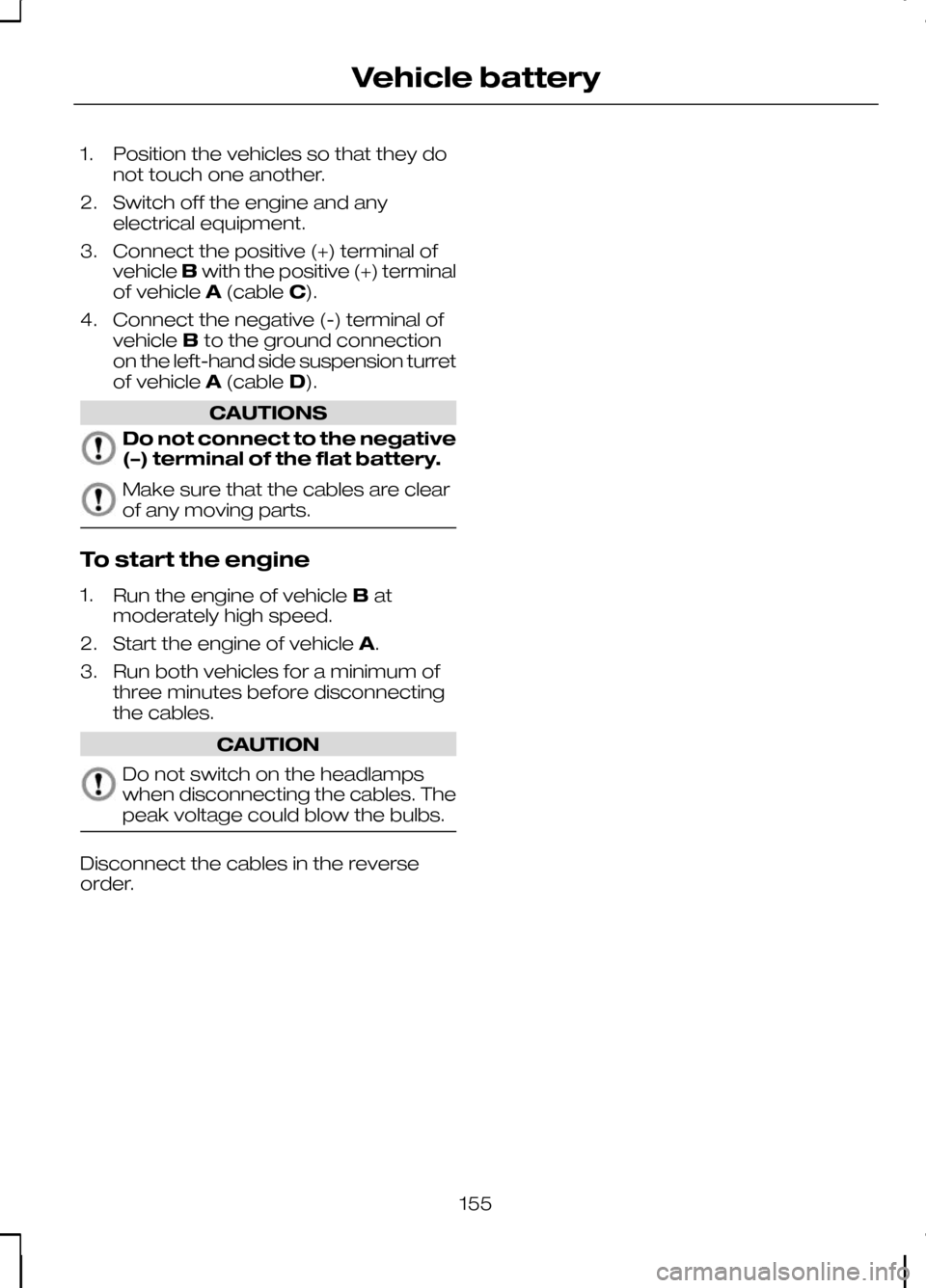
1. Position the vehicles so that they do
not touch one another.
2. Switch off the engine and any electrical equipment.
3. Connect the positive (+) terminal of vehicle Bwith the positive (+) terminal
of vehicle A(cable C).
4. Connect the negative (-) terminal of vehicle Bto the ground connection
on the left-hand side suspension turret
of vehicle A(cable D). CAUTIONS
Do not connect to the negative
(–) terminal of the flat battery.
Make sure that the cables are clear
of any moving parts.
To start the engine
1.
Run the engine of vehicle Bat
moderately high speed.
2. Start the engine of vehicle A.
3. Run both vehicles for a minimum of three minutes before disconnecting
the cables. CAUTION
Do not switch on the headlamps
when disconnecting the cables. The
peak voltage could blow the bulbs.
Disconnect the cables in the reverse
order.
155
Vehicle battery
Page 158 of 226
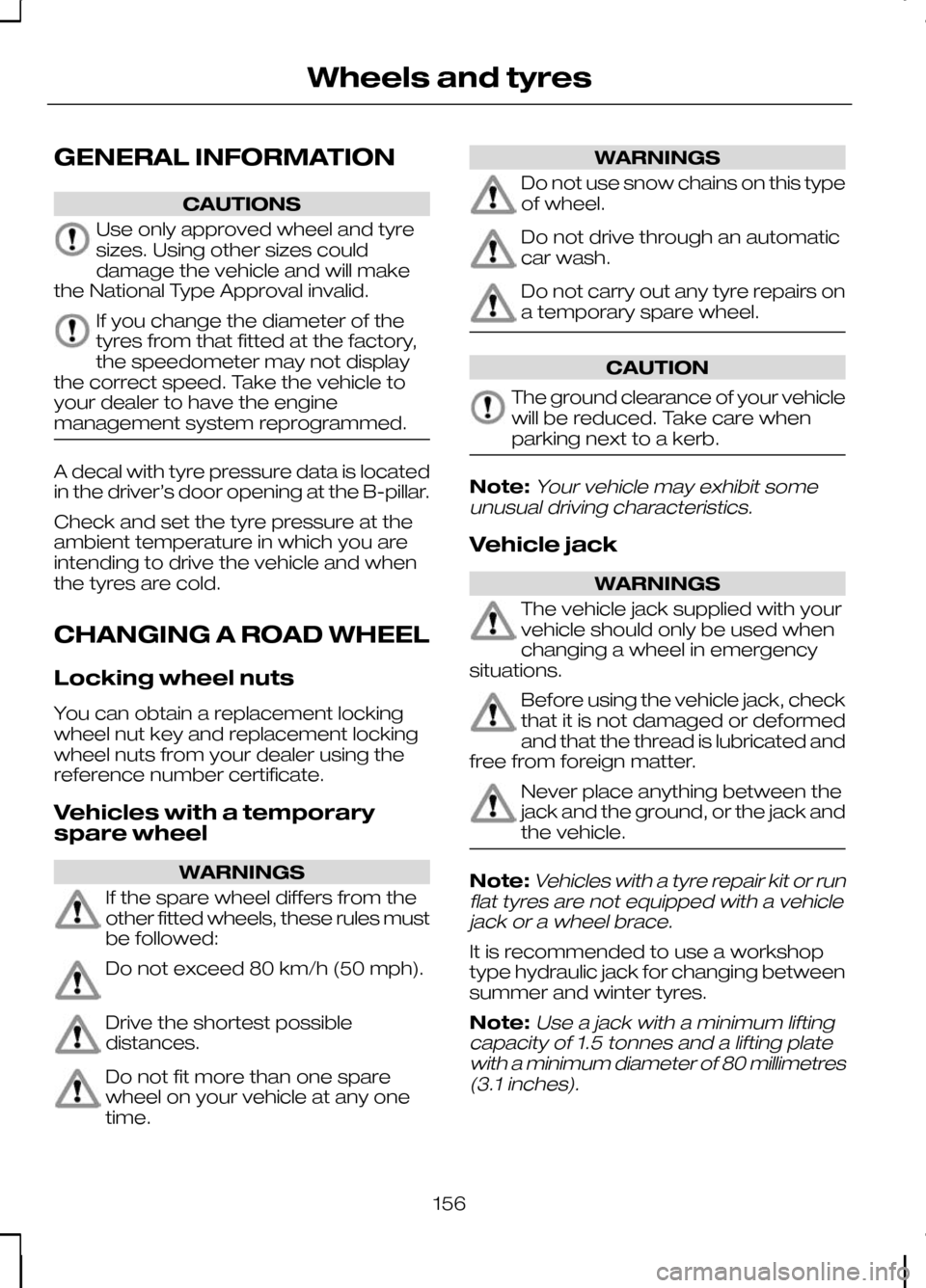
GENERAL INFORMATION
CAUTIONS
Use only approved wheel and tyre
sizes. Using other sizes could
damage the vehicle and will make
the National Type Approval invalid. If you change the diameter of the
tyres from that fitted at the factory,
the speedometer may not display
the correct speed. Take the vehicle to
your dealer to have the engine
management system reprogrammed. A decal with tyre pressure data is located
in the driver’s door opening at the B-pillar.
Check and set the tyre pressure at the
ambient temperature in which you are
intending to drive the vehicle and when
the tyres are cold.
CHANGING A ROAD WHEEL
Locking wheel nuts
You can obtain a replacement locking
wheel nut key and replacement locking
wheel nuts from your dealer using the
reference number certificate.
Vehicles with a temporary
spare wheel
WARNINGS
If the spare wheel differs from the
other fitted wheels, these rules must
be followed:
Do not exceed 80 km/h (50 mph).
Drive the shortest possible
distances.
Do not fit more than one spare
wheel on your vehicle at any one
time. WARNINGS
Do not use snow chains on this type
of wheel.
Do not drive through an automatic
car wash.
Do not carry out any tyre repairs on
a temporary spare wheel.
CAUTION
The ground clearance of your vehicle
will be reduced. Take care when
parking next to a kerb.
Note:Your vehicle may exhibit some
unusual driving characteristics.
Vehicle jack WARNINGS
The vehicle jack supplied with your
vehicle should only be used when
changing a wheel in emergency
situations. Before using the vehicle jack, check
that it is not damaged or deformed
and that the thread is lubricated and
free from foreign matter. Never place anything between the
jack and the ground, or the jack and
the vehicle.
Note:
Vehicles with a tyre repair kit or run
flat tyres are not equipped with a vehicle jack or a wheel brace.
It is recommended to use a workshop
type hydraulic jack for changing between
summer and winter tyres.
Note:
Use a jack with a minimum lifting
capacity of 1.5 tonnes and a lifting plate with a minimum diameter of 80 millimetres(3.1 inches).
156
Wheels and tyres
Page 159 of 226
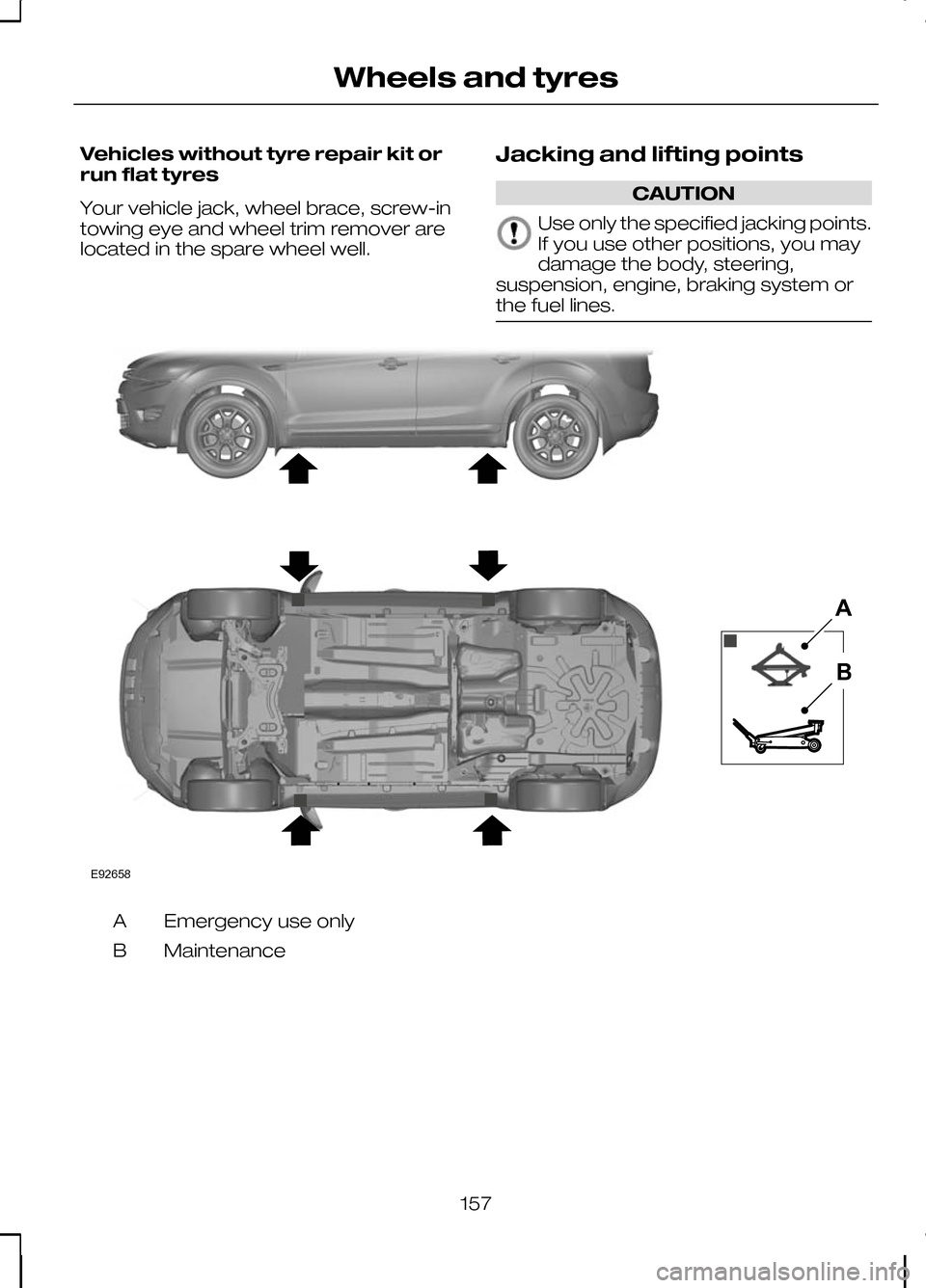
Vehicles without tyre repair kit or
run flat tyres
Your vehicle jack, wheel brace, screw-in
towing eye and wheel trim remover are
located in the spare wheel well.
Jacking and lifting points CAUTION
Use only the specified jacking points.
If you use other positions, you may
damage the body, steering,
suspension, engine, braking system or
the fuel lines. Emergency use only
A
Maintenance
B
157
Wheels and tyresE92658AB
Page 160 of 226

Indentations in the sills
Ashow the
location of the jacking points. Vehicles with side skirts
Assembling the wheel brace
Type one
WARNING
When returning the wheel brace
extension to its original position, take
care not to get your fingers caught.
Note:Make sure that the wheel brace is
fully extended. Extend the wheel brace.
Type two
CAUTION
The screw-in towing eye has a
left-hand thread. Turn it
anti-clockwise to install it. Make sure
that the towing eye is fully tightened. 158
Wheels and tyresE93184A E92932 E93020 E95345 E122546